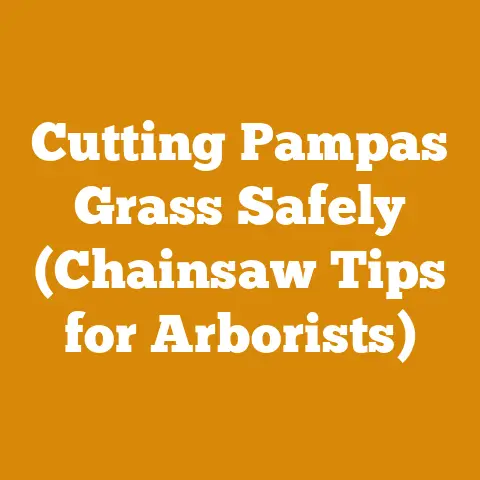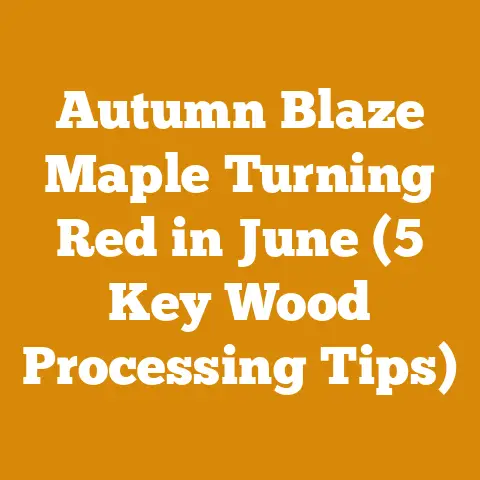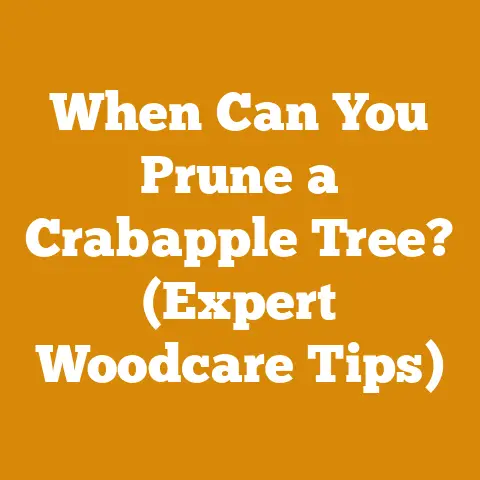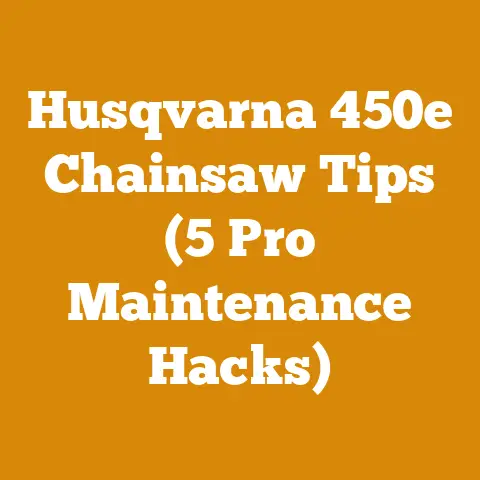How to Remove Dead Shrubs Effectively (7 Pro Arborist Tips)
As the crisp air of autumn descends, painting landscapes in hues of gold and crimson, many of us turn our attention to tidying up our yards.
It’s a bittersweet time, isn’t it?
The beauty of the season is undeniable, but it also signals the end of the growing season and the need to prepare for winter.
One task that often looms large is dealing with dead or dying shrubs.
They stand as stark reminders of the summer’s vibrancy, now withered and lifeless.
I’ve spent years working with trees, shrubs, and wood in various forms, from felling timber in the forests of the Pacific Northwest to meticulously crafting firewood stacks that would make any pyromaniac envious.
I’ve learned a thing or two about the proper way to remove dead shrubs, not just for aesthetic reasons, but also for the health of your garden and, surprisingly, for potential firewood or woodworking projects.
Removing dead shrubs effectively isn’t just about yanking them out of the ground.
It’s about understanding the “why” behind the “how,” respecting the soil ecosystem, and even considering the potential uses of the shrub itself.
In this guide, I’ll share seven pro arborist tips to help you remove dead shrubs effectively, safely, and even sustainably.
We’ll cover everything from identifying dead shrubs to proper removal techniques, root management, and even how to repurpose the wood.
How to Remove Dead Shrubs Effectively (7 Pro Arborist Tips)
1. Diagnosing the Demise: Identifying Dead Shrubs
Before you start hacking away, it’s crucial to confirm that the shrub is truly dead.
Sometimes, a shrub might just be dormant or experiencing a temporary setback.
I remember one spring, a client called me in a panic, convinced their prized rhododendron had succumbed to winter’s wrath.
A quick inspection revealed that while it looked lifeless, the buds were still plump and green beneath the surface.
A little patience and some spring feeding brought it back to its former glory.
Here’s how to tell for sure if a shrub is truly dead:
- Scratch Test: This is your first line of defense.
Use your fingernail or a small knife to gently scrape away a bit of the outer bark on a few different branches.
If you see green tissue underneath, the branch is still alive.
Brown or dry tissue indicates dead wood. - Bud Check: Examine the buds.
Are they plump and firm, or are they dry and brittle?
Healthy buds are a sign of life. - Branch Flexibility: Live branches will have some flexibility and give.
Dead branches are often brittle and snap easily. - Overall Appearance: Consider the overall appearance of the shrub.
Are all the leaves brown and dry?
Is the bark peeling excessively?
Are there signs of fungal growth or insect infestation?
While these can indicate disease, they don’t necessarily mean the shrub is dead, but they should raise a red flag. - Seasonal Considerations: This is crucial!
Deciduous shrubs naturally lose their leaves in the fall and winter.
Don’t assume they’re dead just because they’re bare.
Wait until spring to see if new growth emerges.
2. Tool Time: Gathering Your Arsenal
Having the right tools makes the job significantly easier and safer.
Here’s a breakdown of the essential tools you’ll need:
- Loppers: These long-handled pruning shears are perfect for cutting branches up to about 2 inches in diameter.
Look for loppers with bypass blades for clean cuts.- My Pick: I prefer Fiskars PowerGear2 Loppers for their leverage and durability.
- Hand Pruners: For smaller branches and twigs, a good pair of hand pruners is essential.
Again, bypass pruners are generally preferred.- My Pick: Felco F-8 Classic Pruners are a professional standard for a reason.
- Pruning Saw: For thicker branches that loppers can’t handle, a pruning saw is your best bet.
Look for a saw with aggressive teeth and a comfortable handle.- My Pick: I’m a fan of the Silky GomBoy Professional Folding Saw.
It’s incredibly sharp and portable.
- My Pick: I’m a fan of the Silky GomBoy Professional Folding Saw.
- Shovel: For digging around the base of the shrub and severing roots.
A sturdy spade shovel is ideal. - Pickaxe or Mattock: For breaking up tough soil and stubborn roots.
This is especially helpful for larger shrubs with extensive root systems. - Root Saw: Specialized saw designed for cutting roots underground.
- Gloves: Protect your hands from thorns, splinters, and soil.
Leather gloves are a good choice. - Eye Protection: Safety glasses or goggles are a must to protect your eyes from flying debris.
- Work Boots: Sturdy work boots provide ankle support and protect your feet.
- Chainsaw (Optional): For very large shrubs or those with thick trunks, a chainsaw can be helpful.
Use with extreme caution and only if you are experienced and properly trained. I recommend a small, lightweight chainsaw like the Stihl MS 170 for this type of work.
Remember proper PPE (Personal Protective Equipment) is crucial: helmet, chaps, eye and ear protection. - Winch or Come-Along (Optional): For extremely large or deeply rooted shrubs, a winch or come-along can provide the necessary pulling power.
3. The Cut-Down: Removing the Above-Ground Growth
This is where the real work begins.
The goal is to remove as much of the above-ground growth as possible before tackling the roots.
- Start with the Outer Branches: Use loppers or a pruning saw to remove the outer branches, working your way towards the main trunk.
- Cut at an Angle: When removing branches, cut at a slight angle, just above a bud or branch junction.
This encourages proper healing and prevents water from pooling on the cut surface. - Work in Sections: If the shrub is large, work in sections to make the process more manageable.
- Reduce the Bulk: As you remove branches, cut them into smaller pieces for easier disposal.
- Leave a Stump: Leave a stump that is about 6-12 inches above the ground.
This gives you something to grip when you start digging.
4. Root Awakening: Excavating the Root System
This is often the most challenging part of the process.
The root system can be surprisingly extensive and tenacious.
- Clear the Area: Remove any grass, rocks, or debris from around the base of the stump.
- Dig a Trench: Dig a trench around the stump, about 1-2 feet away from the base.
The depth of the trench will depend on the size of the shrub. - Sever the Roots: Use your shovel, pickaxe, or root saw to sever the roots that are growing into the trench.
Start with the smaller roots and work your way to the larger ones. - Rock the Stump: As you sever the roots, try rocking the stump back and forth to loosen it from the soil.
- Persistence is Key: Be prepared to spend some time on this step.
It may take some effort to completely sever all the roots.
5. The Pull: Removing the Stump
Once you’ve severed most of the roots, it’s time to pull the stump out of the ground.
- Leverage: If the stump is relatively small, you may be able to use a shovel or pry bar to lever it out of the ground.
- Winch or Come-Along: For larger stumps, a winch or come-along can provide the necessary pulling power.
Attach the winch or come-along to the stump and a sturdy anchor point (like another tree or a vehicle).
Slowly and carefully apply tension until the stump is pulled free. - Teamwork: Sometimes, a little teamwork is all you need.
Enlist the help of a friend or neighbor to pull on the stump while you dig and pry. - Root Saw (Again): For those stubborn roots that just won’t budge, go back to the root saw.
Sometimes, you need to expose more of the root to get a good angle for cutting.
6. Soil Salvation: Preparing the Planting Area
Once the stump is removed, you’ll need to prepare the area for replanting.
- Remove Debris: Remove any remaining roots, rocks, or debris from the hole.
- Amend the Soil: The soil in the area where the shrub was growing may be compacted or depleted of nutrients.
Amend the soil with compost, manure, or other organic matter to improve its fertility and drainage. - Backfill the Hole: Fill the hole with the amended soil, tamping it down firmly.
- Level the Area: Level the area with a rake to create a smooth surface.
7. Repurposing the Remains: Sustainable Disposal
Don’t just toss the shrub remains in the trash!
There are many ways to repurpose the wood sustainably.
- Firewood: Depending on the type of shrub and its size, the wood may be suitable for firewood.
Season the wood properly before burning it.
Important Note: Burning certain types of shrubs may release harmful fumes.
Research the specific type of shrub before burning it.- Green Wood vs.
Seasoned Wood: Green wood is freshly cut wood with a high moisture content.
Seasoned wood has been dried for several months, reducing its moisture content and making it easier to burn.
Seasoned wood burns hotter and cleaner than green wood.
I aim for a moisture content of around 20% for firewood.
- Green Wood vs.
- Wood Chips: Use a wood chipper to turn the branches into wood chips for mulch.
Wood chips can be used to suppress weeds, retain moisture, and improve soil health.- My Experience: I once chipped a pile of dead lilac branches and used the chips to mulch my vegetable garden.
The lilac chips added a subtle, sweet fragrance to the garden.
- My Experience: I once chipped a pile of dead lilac branches and used the chips to mulch my vegetable garden.
- Compost: Smaller branches and leaves can be added to your compost pile.
- Craft Projects: Some types of shrub wood can be used for craft projects, such as carving, whittling, or making small furniture items.
- Wildlife Habitat: Pile the branches in a corner of your yard to create a habitat for wildlife.
This provides shelter for insects, birds, and small animals.
Case Study: The Stubborn Boxwood
I had a client who had a massive, dead boxwood shrub in their front yard.
It had been there for years, and its root system was incredibly dense and well-established.
We tried everything: shovels, pickaxes, a come-along, even a tractor.
Nothing seemed to work.
Finally, we decided to rent a stump grinder.
A stump grinder is a powerful machine with a rotating cutting wheel that grinds the stump and roots into small chips.
It’s an effective but potentially dangerous tool, so we took all necessary safety precautions, including wearing safety glasses, ear protection, and heavy-duty gloves.
It took us several hours to grind the stump down to below ground level, but it was ultimately the only way to remove it completely.
The client was thrilled with the results, and we were able to replant the area with a beautiful flowering dogwood tree.
Strategic Insights and Considerations
- Timing: The best time to remove dead shrubs is in the fall or winter when the plant is dormant.
This minimizes stress on the surrounding plants. - Soil Type: The type of soil you have will affect the ease of removal.
Sandy soil is easier to dig in than clay soil. - Shrub Type: Different types of shrubs have different root systems.
Some have shallow, spreading roots, while others have deep taproots. - Safety First: Always prioritize safety when removing dead shrubs.
Wear appropriate protective gear and be aware of your surroundings. - Call a Professional: If you’re dealing with a very large or difficult shrub, or if you’re not comfortable using power tools, don’t hesitate to call a professional arborist.
Next Steps
Now that you have the knowledge and tools, it’s time to put these tips into action.
Start by assessing the dead shrubs in your yard and gathering the necessary equipment.
Remember to prioritize safety and take your time.
With a little effort and persistence, you can remove those unsightly dead shrubs and create a healthier, more beautiful landscape.
Remember, I’ve tackled countless projects like this, and I’ve learned that every situation is unique.
Don’t be afraid to adapt these techniques to fit your specific needs and circumstances.
And most importantly, enjoy the process!
There’s something deeply satisfying about transforming a neglected space into something beautiful and vibrant.
The work you put in now will pay off in a healthier, more attractive yard for years to come.






